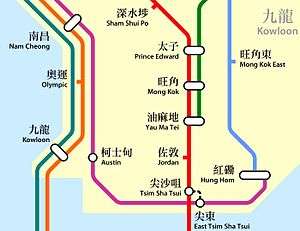Kowloon Southern Link
The Kowloon Southern link is a section of the MTR West Rail line, linking Nam Cheong station and East Tsim Sha Tsui station. The rail link is fully underground, lies along the south-west coastline of Kowloon Peninsula, east of rail tracks of the Tung Chung line and Airport Express. Kowloon Southern Link has one underground intermediate station called Austin station (formerly West Kowloon station). It is located adjacent to the Canton Road Government Offices,[1] close to Kowloon station of Tung Chung line and Airport Express. However, the structures do not provide a direct transfer between the two stations.
Kowloon Southern link 九龍南綫 | ||||||||||||||||||||||||||||||||||||||||||||||||||||||||||||||||||||||||||||||||||||||||||||||||||||||||||||||||||||||||||||||||||||
|---|---|---|---|---|---|---|---|---|---|---|---|---|---|---|---|---|---|---|---|---|---|---|---|---|---|---|---|---|---|---|---|---|---|---|---|---|---|---|---|---|---|---|---|---|---|---|---|---|---|---|---|---|---|---|---|---|---|---|---|---|---|---|---|---|---|---|---|---|---|---|---|---|---|---|---|---|---|---|---|---|---|---|---|---|---|---|---|---|---|---|---|---|---|---|---|---|---|---|---|---|---|---|---|---|---|---|---|---|---|---|---|---|---|---|---|---|---|---|---|---|---|---|---|---|---|---|---|---|---|---|---|---|
Exterior view of Austin station | ||||||||||||||||||||||||||||||||||||||||||||||||||||||||||||||||||||||||||||||||||||||||||||||||||||||||||||||||||||||||||||||||||||
| Overview | ||||||||||||||||||||||||||||||||||||||||||||||||||||||||||||||||||||||||||||||||||||||||||||||||||||||||||||||||||||||||||||||||||||
| Type | Heavy rail | |||||||||||||||||||||||||||||||||||||||||||||||||||||||||||||||||||||||||||||||||||||||||||||||||||||||||||||||||||||||||||||||||||
| System | MTR | |||||||||||||||||||||||||||||||||||||||||||||||||||||||||||||||||||||||||||||||||||||||||||||||||||||||||||||||||||||||||||||||||||
| Locale | Districts: Yau Tsim Mong, Sham Shui Po | |||||||||||||||||||||||||||||||||||||||||||||||||||||||||||||||||||||||||||||||||||||||||||||||||||||||||||||||||||||||||||||||||||
| Termini | East Tsim Sha Tsui Nam Cheong | |||||||||||||||||||||||||||||||||||||||||||||||||||||||||||||||||||||||||||||||||||||||||||||||||||||||||||||||||||||||||||||||||||
| Stations | 3 | |||||||||||||||||||||||||||||||||||||||||||||||||||||||||||||||||||||||||||||||||||||||||||||||||||||||||||||||||||||||||||||||||||
| Technical | ||||||||||||||||||||||||||||||||||||||||||||||||||||||||||||||||||||||||||||||||||||||||||||||||||||||||||||||||||||||||||||||||||||
| Line length | 3.8 km | |||||||||||||||||||||||||||||||||||||||||||||||||||||||||||||||||||||||||||||||||||||||||||||||||||||||||||||||||||||||||||||||||||
| Track gauge | 1,435 mm (4 ft 8 1⁄2 in) | |||||||||||||||||||||||||||||||||||||||||||||||||||||||||||||||||||||||||||||||||||||||||||||||||||||||||||||||||||||||||||||||||||
| Electrification | 25 kV AC, 50 Hz | |||||||||||||||||||||||||||||||||||||||||||||||||||||||||||||||||||||||||||||||||||||||||||||||||||||||||||||||||||||||||||||||||||
| ||||||||||||||||||||||||||||||||||||||||||||||||||||||||||||||||||||||||||||||||||||||||||||||||||||||||||||||||||||||||||||||||||||

History
The project was originally proposed and carried out by Kowloon-Canton Railway Corporation (KCRC) to link the KCR West Rail that terminated at Nam Cheong Station to the KCR East Rail at Hung Hom Station. The tracks between Hung Hom and East Tsim Sha Tsui Station had opened in 2004, to alleviate surface traffic jams and congestion at Kowloon Tong Station caused by passengers transferring between the KCR East Rail and the MTR.
Construction of the Kowloon Southern Link began in late 2005 by the KCRC, after the company's network was taken over by MTR Corporation (MTRC) on 2 December 2007, the project was continued by MTRC. The link went into service on 16 August 2009.[2]
Upon the completion of the rail link, the West Rail Line assumed the tracks from the East Tsim Sha Tsui to Hung Hom portion of the East Rail Line. At the same time both the East Rail and West Rail Lines were altered to terminate at Hung Hom Station, with the platform and tracks at Hung Hom being rearranged to provide cross-platform interchange between the two lines (it will form two sets of island platforms).
Upon the opening of the extension, a new Tuen Mun-Hung Hom Monthly Pass was introduced for unlimited rides of the whole West Rail line (including the new extension). Its current price is $530.[3]
Proposed Canton Road station
Canton Road station (Chinese: 廣東道站) was a planned railway station on the Kowloon Southern Link of West Rail Line between East Tsim Sha Tsui station and Austin station, beneath the shopping mall, Harbour City in Tsim Sha Tsui, by replacing the existing underground car park. But it was never to be built because of the failed negotiations between the KCRC and The Wharf (Holdings) Limited, the owner of the Harbour City.
Originally KCRC requested The Wharf to fully or partially fund the construction of the station for HKD 1.8 billion. The Wharf disagreed, questioning if it was reasonable for a private enterprise to undertake the construction cost of public facilities. The station was eventually omitted from the project, officially announced on 6 December 2004.[4][5]
References
- ETWB (2005). Kowloon Southern Link. LC Paper No. CB(1)609/04-05(04)..
- Press release "Kowloon Southern Link to open in third quarter 2009", 10 July 2009
- "Kowloon Southern Link Opens on 16 August" (PDF) (Press release). Hong Kong: MTR Corporation. 30 July 2009. Retrieved 18 February 2015.
- Canton Road Station, Kowloon Southern Link, Legislative Council of Hong Kong
- "Canton Road Station (CAR)". Archived from the original on 16 July 2011. Retrieved 11 December 2010.
External links

- KDB200 Construction Animation
- MTR – Projects – Kowloon Southern Link
- Environmental Impact Assessment Report of Kowloon Southern Link (approved by EPD)
- Information on Kowloon Southern Link from Subcommittee on Matters Relating to Railways, Panel on Transport, Legislative Council of Hong Kong